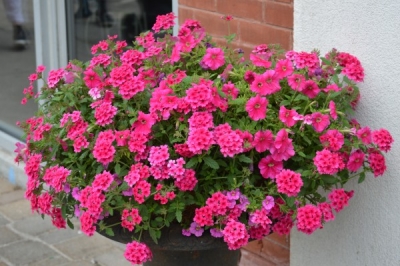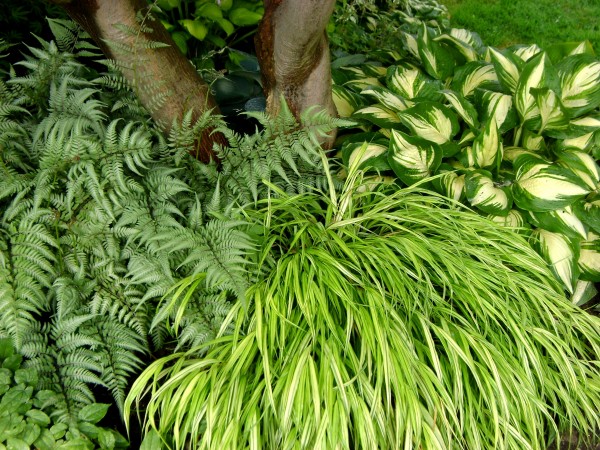
In the small town/ countryside location I saw lots of familiar wild flowers along the side of the road like Queen Ann’s Lace and blue chickory. The fields looked a bit different. The corn was much shorter and at least two weeks from tassel. Instead of beans, tobacco or alfafa, potatoes were the strong second crop. With an average frost-free date almost a month behind Lancaster County, this makes sense.
We spent one day at Niagra Falls. The kids enjoyed getting soaked on the iconic Maid of the Mist. My family then crossed over the border to Canada and went on to visit friends living in Ontario.
Petunias were everywhere- and such lush baskets! The slightly less humid, cooler weather really helped many annuals put on a fantastic display. (Pictured above: Amazing petunias and lantana containers in Ontario)
I mentioned seeing lots of vineyards in Ontario and my friends educated me about “ice wine”. Several wine grape growers specialize in this dessert wine made from grapes not harvested until after they have frosted/frozen on the vine. The grapes must be harvested precisely at the right moment when the freeze occurs often within a few hours, before the grapes begin to rot on the vine. In Ontario this usually happens around Christmas. Ontario produces about 75% of Canada’s “ice wine”.
They also told us Canada grows different varieties of wheat than in the States which affects the crunchiness of their commercial bake goods. Canadian Oreos are MUCH crunchier. Who knew? My kids were also amazed to see milk in a bag instead of a carton or jug. Those crazy Canucks.
The cabin was a few miles from Letchworth State Park. “The Grand Canyon of the East”, this park has the reputation of being one of the nation’s best state parks, but was largely under construction when we visited. Boasting three large waterfalls, a newly constructed nature center, and museum dedicated the history of the Seneca Native Americans and the Letchworth family there is something for everyone.
It was a very relaxing vacation. The nicest thing about being away is I feel no compunction to pull other people’s weeds. Weeds will be our topic next week.

 If you only visit your favorite greenhouse in April or early May there are several annuals that you probably did not even notice. These are heat-loving plants that bloom profusely when the mercury climbs. They thrive when many cool season flowers like pansies and lobelia are petering out and can be depended on to give bright color until frost.
If you only visit your favorite greenhouse in April or early May there are several annuals that you probably did not even notice. These are heat-loving plants that bloom profusely when the mercury climbs. They thrive when many cool season flowers like pansies and lobelia are petering out and can be depended on to give bright color until frost. Ornamental grasses have a fine texture and unique form that blends gracefully with the plethora of daisies and other summer flowers. In the fall, their lovely seed heads play so well with sedums, asters and solidagos. Most often though, the switchgrasses (Panicum), Pennisetums, and Miscanthus are best suited for full sun. When planted in shade they tend to be floppy, not bloom as well and lose their variegation or reddish foliage.
Ornamental grasses have a fine texture and unique form that blends gracefully with the plethora of daisies and other summer flowers. In the fall, their lovely seed heads play so well with sedums, asters and solidagos. Most often though, the switchgrasses (Panicum), Pennisetums, and Miscanthus are best suited for full sun. When planted in shade they tend to be floppy, not bloom as well and lose their variegation or reddish foliage. As I write this, school has been out for one and a half days. While I haven’t heard “I’m bored” yet, it’s because my kids know that as soon as they utter those words, they are pulling weeds.
As I write this, school has been out for one and a half days. While I haven’t heard “I’m bored” yet, it’s because my kids know that as soon as they utter those words, they are pulling weeds.